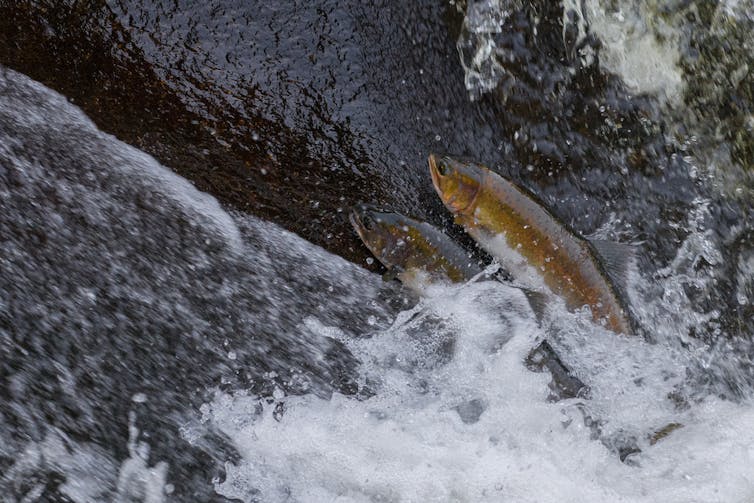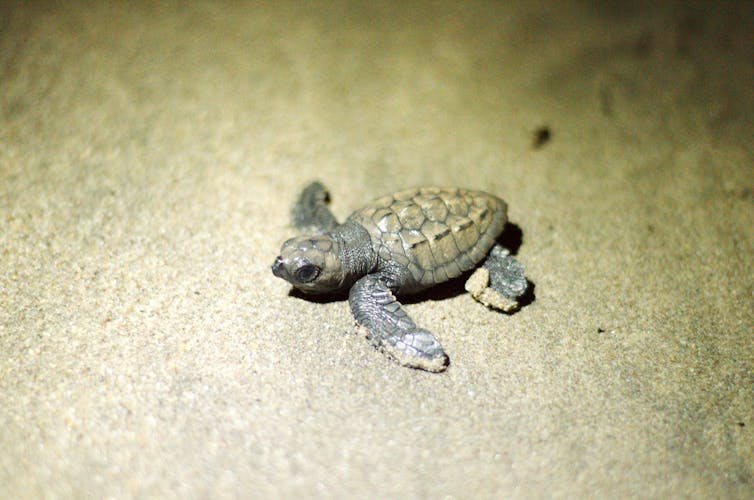Salmon use Earth’s magnetic field to create a large-scale mental map which they follow to find suitable feeding grounds, a study published today in Current Biology has found.
The salmon are born in rivers and live out the early part of their lives in freshwater before travelling hundreds or thousands of kilometres out into the open ocean, where they spend most of their adulthood.
It has long been suspected that salmon use Earth’s magnetic field to navigate during this long migration.
But until now, the way that young salmon swim from their streambed out into the open ocean with no previous knowledge of the sea, nor any parents or experienced fish to follow, has been a mystery.
Inherited magnetic map

Many marine animals, like salmon, undertake long-distance migration with no previous learnt experience.
Previous work has suggested they might be guided, in part, by taking cues from regional magnetic fields to determine the best course – termed the “inherited magnetic map”. Because this map is inherited the salmon do not require any previous knowledge of their migration path or location.
The idea of an inherited magnetic map has long been speculated, but until now there has been no empirical evidence to suggest that salmon can determine their geographic position using the geomagnetic field.
Nathan Putman from Oregon State University has now shown that salmon do navigate using an inherited magnetic map.
“Our findings are certainly suggestive that before the fish even hit the ocean, they have information about how they should orient to reach, or remain in, favourable locations,” Dr Putman said.
Swimming the right way
Dr Putman and colleagues tested young Chinook salmon against different magnetic fields, either north or south of their typical ocean range, and found that the fish orientate themselves back towards their home range. If a fish was exposed to a north magnetic field, for instance, it would change its swimming direction back south.
Putman and colleagues also examined magnetic field components (magnetic intensity and the inclination angle) to determine which feature the fish use as a cue and found that neither of the features alone elicited the complete turn-around response, indicating that salmon rely on a combination of the two.
The results of the study also suggest this trait is inherited, as salmon are able to navigate without requiring any previous learning.
“It’s a crude system,” Graeme Hays from Deakin University said. “It’s not quite like the way we would use a GPS in our car, for very fine scale navigation, but instead the salmon are using geomagnetic cues in a broad way.”
Turtles and other marine animals
Putman and his colleagues have previously shown the existence of an inherited magnetic map in sea turtles, which also cover long distances in their early dispersal periods.

The mechanism is very similar to the ones used by the salmon.
Sea turtle hatchlings use geomagnetic navigation to swim away from the shore to the relative safely of the open ocean. When the females lay eggs, they use this magnetic map that they developed while younger to find the beach on which they hatched.
The authors of the paper think it is very likely that this navigation technique may be used in a number of other marine mammals that undertake long distance migrations, such as seals, whales and sharks.
“I’m certain that we will find the same pattern in other marine species,” Professor Hays said. “In the future I hope we will get a more holistic view of all the different components that influence where animals go. Certainly geomagnetic information is one components, but ocean currents will be important as well.”
An explanation for failed introductions?
Salmon are absent from the wild in the southern hemisphere, despite countless attempts to introduce them. May trials for introducing salmon to Australia and Chile have failed.
Tim Dempster, from the University of Melbourne, said this may be, in part, due to the difference in magnetic fields.
“The results of this paper would suggest that their inherited magnetic maps have a lot to do with this failure, as when they head out to sea for their marine phase from these new places, they might go in the wrong direction when trying to migrate home and get lost in the ocean,” Dr Dempster said.
This is just one of the many questions to arise from this exciting discovery, which has improved our understanding of how marine animals navigate across the vast ocean.


